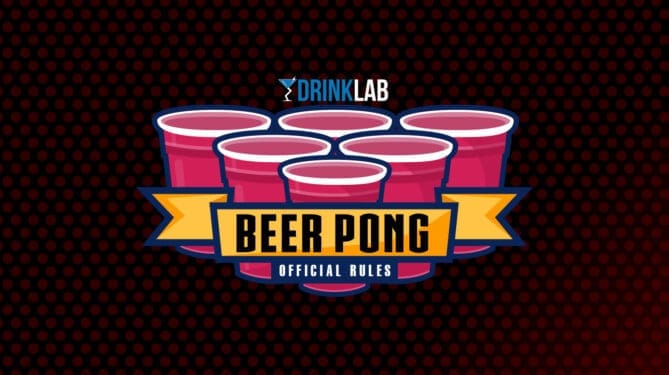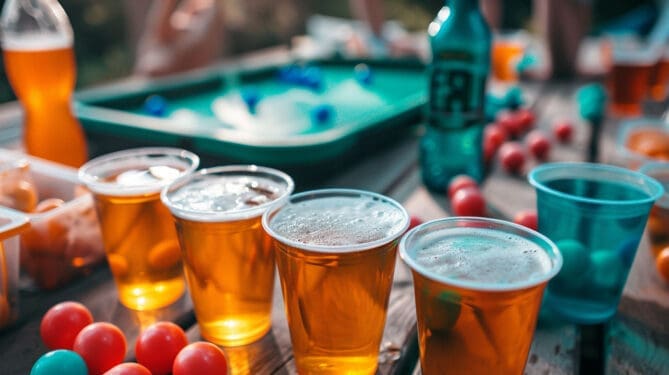The Official Rules of Beer Pong (A.K.A. Beirut)
Beer Pong, often interchangeably known as Beirut, has emerged as a quintessential staple in the realm of social games, particularly resonating with the vibrant energy of college campuses and casual gatherings. This beloved game, which masterfully blends skill, strategy, and a dash of luck, has roots that delve deep into the cultural fabric of youthful camaraderie and spirited competition. Its simplicity, requiring nothing more than a table, cups, ping pong balls, and beer (or any preferred beverage), belies the rich and varied experiences it offers to its participants.
The popularity of Beer Pong transcends mere entertainment; it’s a social ritual, a rite of passage for many, and a unifier that brings together friends and strangers alike over a playful battlefield. The game’s essence lies not just in its competitive spirit but also in its ability to forge lasting memories and stories worth recounting. From dorm rooms to dedicated tournaments, Beer Pong has evolved, yet the core of what makes it appealing remains unchanged: the thrill of landing that perfect shot and the laughter that ensues, irrespective of the outcome.
As we dive into the depths of Beer Pong, this article aims to demystify and lay down the official rules of the game. Whether you’re a seasoned player, a curious newbie, or simply a fan of the culture surrounding it, these guidelines will serve as your comprehensive playbook. We will explore everything from the basic directions to the intricate rules that govern this game, ensuring you’re well-equipped for your next Beer Pong showdown. So grab a cup, line up your shots, and let’s delve into the official rules of Beer Pong, a game that has become more than just a pastime—it’s a symbol of fun, friendship, and festive competition.
Quick Links:
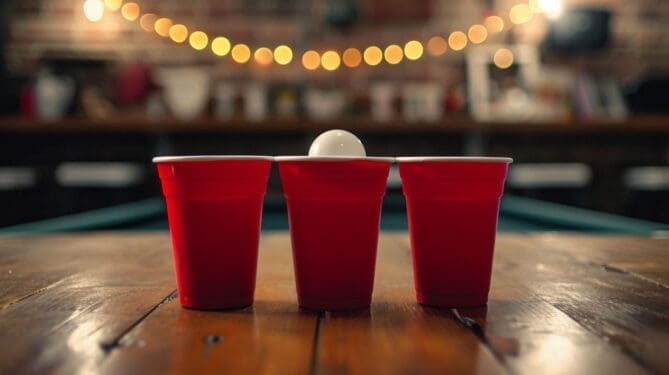
Equipment and Setup
To embark on the journey of playing Beer Pong, a few essential items and a proper setup are paramount. This section will guide you through everything you need to get your game up and running, ensuring that your Beer Pong experience is as authentic and enjoyable as possible.
A. Required Equipment
- The Table: The heart of the game. Ideally, a Beer Pong table should be around 8 feet long, 2 feet wide, and set at a comfortable height. However, any similar-sized table or flat surface will suffice in a pinch.
- Ping Pong Balls: Typically, two or more standard-sized ping pong balls are used. It’s always good to have a few extras in case of wear and tear or the inevitable stray shot.
- Cups: You will need 20 cups — 10 for each side of the table. These are usually 16-ounce plastic party cups, preferred for their durability and size.
- Beer or Alternative Beverages: Traditionally, beer is used, but any beverage, including non-alcoholic options, can be substituted to cater to all participants.
B. Setting Up the Table
- Positioning the Table: Place the table in an open area with enough room around it for players to move freely.
- Arranging the Cups: Each side of the table gets a triangle formation of 10 cups, arranged in a 4-3-2-1 format. The point of the triangle should face the opposing team.
- Filling the Cups: Fill each cup with beer or the chosen beverage. The amount is typically around one-third to half a cup, but can be adjusted based on preference or rules.
C. Additional Considerations
- Water Cup: It’s common practice to have a separate water cup for rinsing the ping pong balls if they fall on the floor or become dirty.
- Playing Area: Ensure there’s adequate lighting and that the playing area is safe from hazards that could cause spills or accidents.
- Players and Teams: Beer Pong is generally played with two teams, each consisting of one or two players. However, the number can be adapted for larger groups or tournament play.
With your equipment ready and the table set up, you’re now prepared to start delving into the heart of Beer Pong — the gameplay. Remember, while the setup is important, it’s the spirit of competition and camaraderie that truly makes Beer Pong a cherished activity.
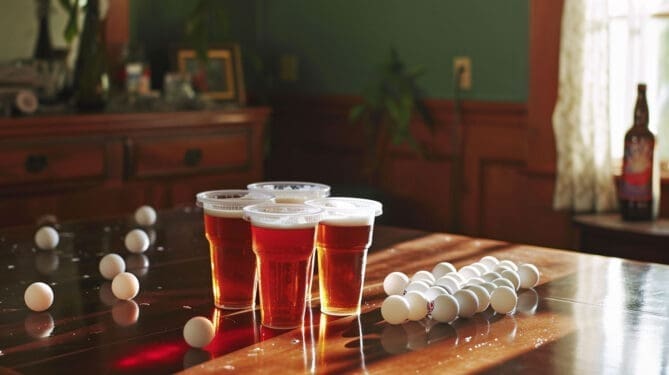
Basic Beer Pong Directions
Understanding the basic directions of Beer Pong is crucial for both new players and seasoned enthusiasts. This section breaks down the fundamental aspects of how to play the game, providing a clear pathway for engaging in this competitive yet fun activity.
A. Objective of the Game
The primary goal in Beer Pong is to throw or bounce ping pong balls into the opposing team’s cups. When a ball lands in a cup, the opposing team must drink the contents of that cup. The game ends when one team eliminates all of the other team’s cups.
B. Gameplay Overview
- Determining the First Turn: The game begins by deciding which team goes first. This can be done through a ‘face-off’ or a coin toss.
- Taking Turns: Teams alternate throwing ping pong balls into their opponents’ cups. Each team typically gets two throws per turn (one throw per team member in doubles play).
- Throwing Techniques: Players can either toss the ball directly into a cup or bounce it off the table into a cup. Bounced shots are riskier but often have strategic advantages, like removing two cups instead of one if successful.
C. Rules for Throwing
- Elbow Rule: When throwing, players must keep their elbows behind the edge of the table. This rule is to ensure fair play and consistent throwing distances.
- Distractions: While the opposing team is allowed to distract the shooter, physical interference with the ball or player is not allowed.
D. Drinking Rules
- Drinking the Contents: When a ball lands in a cup, the contents of that cup must be consumed by the team that owns the cup.
- Cup Removal: Once a cup is hit and its contents drunk, it is removed from the table.
- Order of Drinking: Generally, cups are drunk in the order they are hit. Some variations allow for strategic drinking order.
E. Ball Retrieval
After a throw, balls that have not landed in cups can be retrieved and reused. If a ball rolls back to the throwing side after hitting the table, that team may attempt a ‘behind the back’ or ‘trick shot’ throw.
F. Continuation of Play
The game continues with each team taking turns until one team eliminates all of the opposing team’s cups. The pace of the game, while lively, should allow for players to enjoy their drinks responsibly.
These basic directions offer a foundation for playing Beer Pong. However, the game can be adapted with various house rules and variations, which add unique twists and additional strategy to the gameplay. Remember, the essence of Beer Pong lies in its blend of skill, chance, and social interaction, making every game a unique and enjoyable experience.
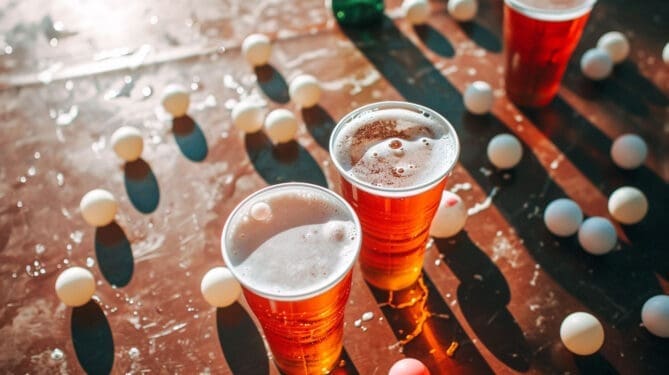
Formation and Re-racking
In Beer Pong, the arrangement of cups and the strategy behind their re-racking are integral to the gameplay. Understanding these aspects can significantly enhance the experience and add an element of strategy to the game.
A. Initial Cup Formation
- Triangle Setup: At the start of the game, each team arranges their 10 cups in a triangle formation, pointing towards the opposite end of the table. This is usually in a 4-3-2-1 format, resembling a pyramid.
- Centering the Triangle: The back corner cup of the triangle is typically centered at the end of the table, ensuring equal distance from each side.
B. Re-racking Basics
- What is Re-racking?: Re-racking, or rearranging the remaining cups, is a strategy used to consolidate them into a more convenient shape, making it easier to aim and score.
- Timing for Re-racking: Teams are generally allowed to call for a re-rack at specific points in the game. The most common times are when they are down to six, four, three, or two cups.
C. Common Re-racking Formations
- Six Cup Formation: A smaller triangle (3-2-1) or a straight line of six cups.
- Four Cup Formation: A diamond or square formation, often used to consolidate cups towards the center.
- Three Cup Formation: A triangle (3 in a row) or a vertical line, depending on team preference.
- Two Cup Formation: Placed side by side or end to end, depending on the preferred difficulty.
D. Rules and Etiquette for Re-racking
- Limited Re-racks: Teams are typically limited to one or two re-racks per game, so it’s important to use them strategically.
- Mutual Agreement: Both teams should agree on the number of re-racks before the game begins.
- Timing of Re-rack Requests: Re-racks are usually requested at the beginning of a team’s turn, before they throw.
E. Additional Considerations
- Gentleman’s Shot: Some games include a rule for a ‘gentleman’s shot’ – a final re-rack into a single cup, when only one cup remains.
- Custom Formations: While traditional formations are common, players may agree on custom re-racking formations before the game for added variety.
The formation and re-racking rules in Beer Pong not only make the game more interesting but also require players to be tactical about their shots and strategies. As with many aspects of Beer Pong, the re-racking rules can be modified based on house rules, adding a personal touch to each game.



